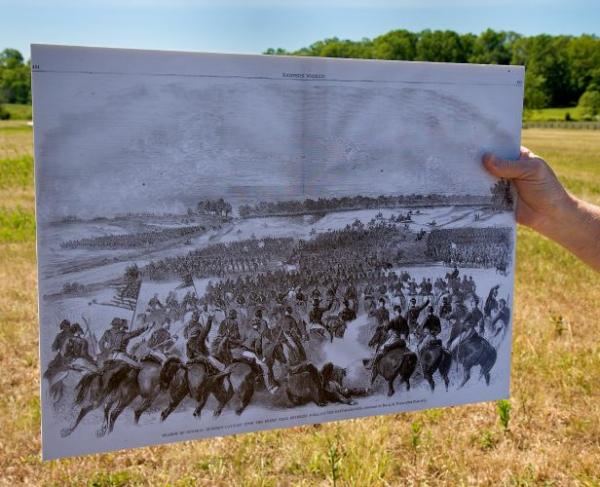Camping in Culpeper
The Army of the Potomac's Winter Encampment, 1863-1864
A biting cold shrouded the landscape as the weary men in blue trudged toward their temporary homes. 1863 had been a year of peaks and valleys for the Army of the Potomac. A promising opening to the spring campaign ended in disaster at Chancellorsville. Two months later, they defeated Robert E. Lee and the Army of Northern Viriginia at Gettysburg. Autumn was followed up two more victories at Bristoe Station and Rappahannock Station. Then, just days earlier, rather than launch a costly frontal assault against the Confederate position along Mine Run, the army commander, Maj. Gen. George G. Meade decided to call off the attack. Meade then turned his columns back toward the Rapidan and in early December the army spread out in its winter encampment across the rolling hills and fields of Culpeper County.
The I Corps occupied the area southwest of the hamlet of Culpeper Court House and the II Corps stretched westward from Stevensburg. Brig. Gen. Alexander Hays’ division occupied Hansborough’s Ridge. Once traversed by Continental soldiers under the Marquis de Lafayette this giant loomed over surrounding landscape acting as a sentry to the eastern approach to Culpeper. The ridge is preserved by the American Battlefield Trust and can be visited with permission.
Elements of the III Corps camped adjacent to the II Corps and south of the courthouse. The V Corps was just across the Rappahannock River in Fauquier County while the cavalry patrolled the outer fringes. The VI Corps camped on the old Brandy Station battlefield. Their commander, Maj. Gen. John Sedgwick established his headquarters at the Welford House or Farley. From there, “Uncle John” could look out over ground where Brig. Gens. John Buford and William Henry Fitzhugh “Rooney” Lee once clashed on Yew Ridge. Maj. Gen. William French set up his headquarters on the “famous plateau” on Fleetwood Hill. Meade also camped on the eminence within sight of French. Nearby, the 6th U.S. Cavalry tore down St. James Church to use the bricks for their huts. Fortunately, Lt. Louis H. Carpenter sketched the church for posterity before the dismantling. The American Battlefield Trust has created a digital AR model of the church here: https://www.battlefields.org/learn/augmented-reality/st-james-church-brandy-station
“Here at Headquarters the only sounds are the distant car-whistles and the drums and trumpets sounding the calls” Lt. Col. Theodore Lyman of Meade’s staff wrote. “Indeed, the music of the band, which is hardly a noise and is very acceptable.” Despite the tranquil feeling, not all was pleasant at army headquarters. Facing scrutiny for his actions over the past year, Meade often traveled to Washington to testify in front of the Congressional Joint Committee on the Conduct of the War. “It would be farce” Meade wrote to his wife, Marguerite, for him to be replaced. Meade withstood the criticism and remained in command.
Although dealing with politicians, Meade also tended to affairs in camp. Due to high casualties and to make his army more manageable in the field, he dissolved the I and III Corps. The V Corps absorbed the I, the II Corps the divisions of the III. Their commanders, Maj. Gens. John Newton and William French were also removed, along with head of the V Corps, Maj. Gen. George Sykes.
On March 10, the new General-in-Chief, Lt. Gen. Ulysses S. Grant visited Meade. Grant recognized that Virginia would be the critical theater of the war in the spring and decided to travel with the Army of the Potomac. It presented an awkward position for Meade, but Grant assured him that he would focus on strategy and leave the tactics to Meade. Still, Grant dealt with administration, replacing Maj. Gen. Alfred Pleasonton, Meade’s cavalry chief, with Maj. Gen. Philip Sheridan. He also transferred Brig. Gen. Judson Kilpatrick, the head of the Third Division in the cavalry corps. Brig. Gen. James Wilson took over for Kilpatrick.
On May 4, 1864, the army rousted itself and began making their way to fords on the Rapidan, opening the spring campaign. The roads would lead them to the Wilderness, Spotsylvania, Cold Harbor, Petersburg and finally to victory at Appomattox Court House eleven months later.











